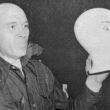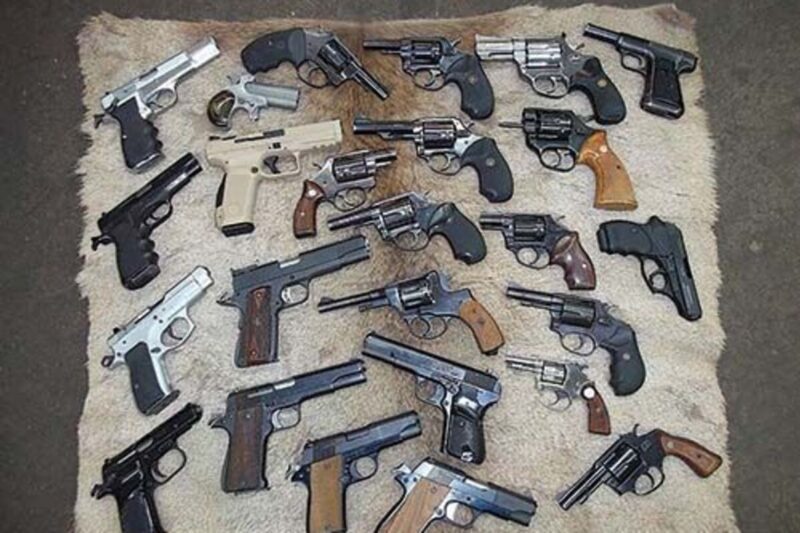Jeff Hutchins
Special to The New Era
It’s usually a wise decision to go with a name-brand item, but if you are intimately familiar with a certain area you can sometimes come up with a good substitute. In rare cases, the substituted unknown brand is even better.
Such is the case with firearms, for sure.
One manufacturer of firearms almost no one has heard of is CANiK (yes, that’s how you spell it, it is Turkish). This is an ISO 9001-certified manufacturer that makes some very good guns. I have two of their pistols and have sold a bunch more. The Desert Tan pistol shown in the photo is kind of a GLOCK/Walther hybrid that actually has a better trigger pull than either of those two.
The silver pistol with the cocked hammer to the right of it is a CZ-75 Compact clone. I waited for this pistol for about 20 years. CZ (a Czechoslovakian company) never imported a lightweight aluminum alloy frame, compact CZ-75 with a standard safety allowing cocked-and-locked carry.
When they finally imported the alloy frames, they all had decockers, none with standard safeties. I was reading American Handgunner magazine several years ago and saw this pistol offered by some importer I had never heard of before. I could not locate them.
Luckily, Tri-Star Sporting Arms became the importer and one of my wholesalers started carrying the pistol I had been looking for. They even had it available in the hard chrome finish I wanted. I ordered one immediately but didn’t know what to expect. I only ordered it sight unseen as I had dealt with numerous Turkish-made shotguns and they had all been very nicely made.
My pistol was one of the earliest ones and the trigger pull was not really great so I stripped it down and did a trigger job, installed factory CZ compact rubber grips and a 13-round CZ magazine as the CANiK-supplied one is an extended 15 round.
Functionally, it has been great, it has fed every round I’ve thrown at it with no problems whatsoever and shoots right to the point of aim. Later, I came across one of the rare surplus imported real CZ-75 lightweight compacts on Gun Broker and, of course, bought it. I will never sell the CZ, but I actually like the CANiK 55/Tri-Star C-100 better.
One manufacturer which has never received the recognition it deserved was Charter Arms.
They made excellent but inexpensive revolvers that actually bested their competition in some areas. Though never fit and finished as well as a big-name gun, they were, nevertheless, well-made. They do have a cheap “feel” to them, somewhat, but that feel is unjustified as the revolvers have an all-steel frame and cylinder.
Some did have an aluminum shroud around the barrel and many had an aluminum grip frame.
That aluminum is one of the things I liked about them. A Charter Arms revolver will be a few ounces lighter than the equivalent Smith & Wesson, but will be every bit as strong, if not stronger.
The reason for that is the engineering of the Charter. The main frame surrounds the cylinder and is all one piece, including both sides. Then the grip frame and lock work come in from the bottom and top. The frame doesn’t have a big chunk of metal that unbolts from the side to get to the “guts” like a S&W, Colt, Rossi etc. In this respect it is much like the extremely strong Ruger double-action revolvers.
The front sight is also much wider on the Charter than it is on the S&W and most of its contemporaries. That fat front sight is much easier to pick up and align than a skinny blade. The newer Charter revolvers are definitely not as well made as the older ones and all of my Charters are of the original manufacture.
The oldest of the guns pictured is Star, a very old Spanish gun maker. They were mostly imported by Interarms, which also imported Walthers and the like. When Sam Cummings, the owner, died in 1998 no one seemed willing or able to keep Interarms afloat and they went out of business.
Since then I haven’t seen new Star pistols for sale anywhere. Regardless, they made quality products and, in at least one case, a world innovator.
The models of Star pistols manufactured over the years provide enough information for at least one book, but two models stand out. The first was the Star PD chambered in 45 ACP. This was the first compact production semi-automatic pistol chambered in .45 and, as such, a big hit with shooters. All of a sudden there was a pistol not much bigger or heavier than the traditional snub-nosed .38, but held seven .45s!
The amazing thing was how long it took the other manufacturers to catch on and produce their own versions; it was decades. The pistol did have a reputation as not being the most durable pistol out there but it was made to be carried a lot and shot a little. In that role it was/is exactly what it was supposed to be.
Pictured are a well used/carried older model with all of the steel parts re-blued and a cherry slightly later model. I’d like to have one with the nickel Starvel finish but have never come across one.
The second model of Star that really made a splash in America was the Firestar. These little gems were extremely well made and offered in 9 mm, .40 S&W and .45 ACP. They were single-action only, like most Star pistols including the PD, and were offered in blued steel and Starvel.
In my observation, unlike the PD, the silver Starvel finish was way more popular. The only mistake they made, in my opinion, was making the little pistols all steel. A lightweight version would have been a really sweet carry gun. I’ve never owned a Firestar but have sold many over the last couple of decades.
Rossi is probably known to many shooters but I still include it as an off-brand gun. Their revolvers are very similar to Smith & Wesson’s. The finish varies from quite good to serviceable. The older ones weren’t the best, the newest ones are pretty good, but the in-between vintage were the best of the breed – kind of like Taurus, which used to be their competition from Brazil but now owns them.
Shown in the photo is a poor-condition older one (third up from far right) and a very nice “in-between” vintage in the lower right corner. The cute little one in between is a rare-nickel plated Baby Rossi .22. in fantastic shape.
While on the subject of revolvers, Astra is largely unknown, even by those who do think of them as a pistol manufacturer. Astra’s best product was probably their revolvers, however, also imported by Interarms from Spain.
Any Smith & Wesson collector will tell you that the “pinned and recessed” versions are the ones you want. This means a pinned barrel and recessed chambers in which the cylinder has the chambers cut into it in such a way that there is a recess in it for the rim of each cartridge. Even better with the S&W is to have a “five screw.” The newer S&Ws have only four screws on the exterior of the gun where they used to have five. The missing two were lost to cost-cutting measures over the years.
Astra revolvers were five screws and were pinned and recessed right up until the end. The fit and finish was better and the tolerances were tighter to boot. Astra also used coil springs throughout the design, not leaf mainsprings as S&W and Colt do.
Under the grip hides a most ingenious contraption as well. The coil hammer/main spring strut goes through a circular ring with four holes bored in it. Each hole has a deeper and deeper seat in it for the mainspring.
This device allows you to fine tune the hammer spring to find the setting that will give 100 percent ignition reliability with any chosen ammo. The advantage to this is that the lower the spring tension, the lighter the trigger pull is. Nobody else offered anything like this. In this case the off-breed is better.
Two Astra revolvers are pictured. The stainless steel revolver clear at the top right is a 2¾-inch barreled .44 Magnum Astra Terminator. This is one of the coolest named guns ever and one of my favorite revolvers. The one under it is an Astra .357 Magnum with a no-inch barrel. The barrel is completely gone – literally blown off!
The rest of the revolver is totally functional but some kind of barrel obstruction or screwed-up hand load blew the barrel off and cracked the frame longitudinally right through where the barrel screws in. I keep it around in case I end up needing any parts for my Terminator but so far the Astra has been 100 percent and the parts gun remains untouched. Someday I hope to add a blued version to the collection.
Rounding out the revolvers shown is the strange Russian Nagant revolver. It is easy to spot towards the middle as it is much different than anything else pictured.
Here is a list of its oddities: It’s a seven shot, it’s double-action but loads and unloads like a single-action, the cylinder goes around like normal but also forward and the firing pin is about three times as long as any normal revolver’s would be.
The forward-traveling cylinder is actually a desirable unique feature. The cartridge is very strange, as the brass casing extends past the bullet.
When fired, the cylinder goes up and sticks the nose of the cartridge up into the end of the barrel, the protruding case expands and lets the bullet through, simultaneously sealing off the normal barrel-to-cylinder gap.
This makes it about the only revolver that can be effectively used with a sound suppressor and also eliminates the velocity loss through the gap of a normal revolver.
Most people think Savage is only a rifle manufacturer, and many know they made a huge variety of shotguns – some good, some not so much. But they also made pistols and one .22 that looks like a single-action revolver but is actually a single-shot.
The strange-looking auto pistol in the upper right hand corner is a Savage Model 1907 in .32 ACP. These pistols were made in a variety of slight modifications and models and even some rare versions were made in .45 ACP for the military trials that eventually selected the 1911 Colt/Browning.
No less an authority than Bat Masterson endorsed these pistols (after he was paid, of course), stating that “even a tenderfoot, with a 10-shot Savage pistol, could have bested the toughest Old West gunfighter!”
Another of their favorite slogans was “10 shots, quick!” I remember an old ad showing an outdoorsman shooting at an attacking crocodile or alligator as he was backing away from a water-side confrontation. These pistols do shoot well and point well, but I think the advertising was a little over the top.
Many shooters have a bad impression of derringers, since most are little more than junk. The exception is American Derringer Corporation and Bond Arms.
ADC was first to market with a high-quality version but Bond seems to have taken over the market.
The derringer shown is an ADC chambered in .45 ACP with lightweight alloy frame. Yes, it gets your attention when you shoot it, but it’s controllable. I ordered it as back-up for my assorted .45 ACP pistols and revolvers, as it’s easy to keep feeding the two chambers from a pistol magazine. I hardly ever actually carried it, though, and sold it once to a lady customer.
I almost immediately regretted that and just got lucky enough to buy it back later. I still hardly ever carry it but I like knowing it’s “home.”
The ADC has an ingenious device as well. The safety is a spring-loaded round lug that you lower the hammer onto. It is thusly trapped by the hammer but when you cock it, the lug springs out of the way and lets the pistol be fired. It’s a great idea and makes the derringer safe to carry and quick to fire.
The quality of Bersa pistols has put them on the map of many gun buyers but they are by no means a household name. They are direct competition to Walther’s PPK line of pistols and also the Sig Sauer 230/232 line, as well as many others.
The upside is that the cost is little more than half of the big guys’. The startling news is that even if the cost were the same I would still buy the Bersa! It’s lighter than the Walther, which is only available in all steel (except for some extremely rare .32 PPKs), and the Bersa has an alloy frame.
The trigger pull is lighter than the SIG in most examples and the Bersa seems to like all types of .380 ammo.
The Bersa also has an external slide stop, which neither of the others do. That is a big advantage to me as it makes handling, field stripping and just general safety much better.
My Bersa is the only one pointing down in the photo and is the CC model (concealed carry). It’s a little more compact than the standard model and more rounded on the edges for more comfortable carry. I don’t carry it much except in the summer time when its flatness counts while stuffed in the waist band.
I have already done an article on the Hi-Power pistols but an Argentine Detective model and a Silver Chrome clone by FEG are pictured to the far right top corner of the group. Both are nice Hi-Power copies but not quite as good as the real thing.
The last batch of pistols I want to mention here are copies of the ubiquitous Colt 1911 – easily the most-copied firearm in history. I am going to concentrate on the Philippine models here, though. The only one shown is a slightly customized Strayer Tripp International (STI) Spartan 5-inch barrel, the big auto just beneath the desert tan CANiCK in the photo.
This is the only Philippine pistol I currently own and had no need for it whatsoever, but they are such a huge value that I added one to my collection of “Old Slab Sides.”
Slightly lesser versions sold are the Rock Island, American Classic, Armsport, Sportarms etc. etc. etc.
My second favorite behind the STI is ATI, American Tactical Imports. I have owned these and even sold one of mine to my dad. I always have an STI or ATI in the shop, usually in the Commander (4-4.25” barrel) length. Sometimes I have both brands in stock.
None of these Philippine pistols are bad, however, and you really can’t go wrong with any of them.
If the prospective buyer is willing to do some research and ask the right people the right questions, often jewels can be found at rock prices.





